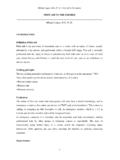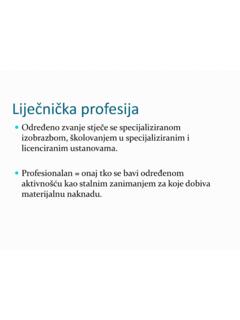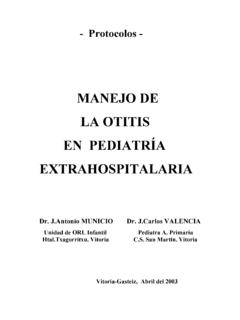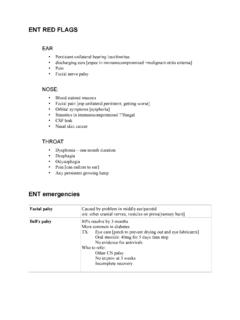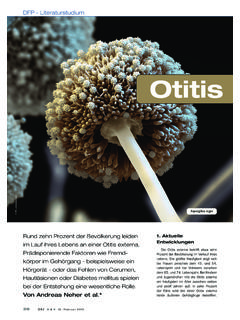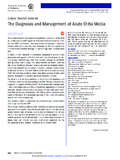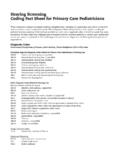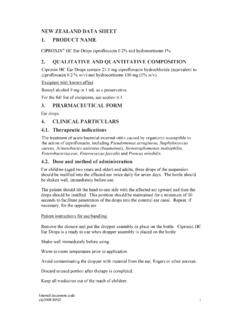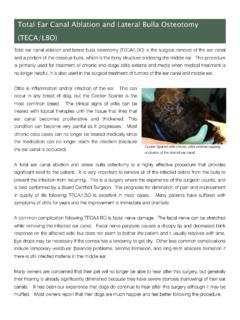Transcription of Clinical practice guideline: Acute otitis externa
1 ORIGINAL RESEARCHC linical practice guideline: Acute otitis externaRichard M. Rosenfeld, MD, MPH, Lance Brown, MD, MPH,C. Ron Cannon, MD, Rowena J. Dolor, MD, MHS,Theodore G. Ganiats, MD, Maureen Hannley, PhD,Phillip Kokemueller, MS, CAE, S. Michael Marcy, MD, Peter S. Roland, MD,Richard N. Shiffman, MD, MCIS, Sandra S. Stinnett, DrPHandDavid L. Witsell, MD, MHS,Brooklyn, New York; Loma Linda, California;Jackson, Mississippi; Durham, North Carolina; San Diego, California; Dallas, Texas;New Haven, Connecticut; and Alexandria, VirginiaOBJECTIVE:This guideline provides evidence-based recom-mendations to manage diffuse Acute otitis externa (AOE), definedas generalized inflammation of the external ear canal, which mayalso involve the pinna or tympanic membrane. The primary pur-pose is to promote appropriate use of oral and topical antimicro-bials and to highlight the need for adequate pain DESIGN:In creating this guideline, the AmericanAcademy of Otolaryngology Head and Neck Surgery Foundation(AAO-HNSF) selected a development group representing thefields of otolaryngology head and neck surgery, pediatrics, familymedicine, infectious disease, internal medicine, emergency medi-cine, and medical informatics.
2 The guideline was created with theuse of an explicit, a priori, evidence-based :The group made astrong recommendationthatmanagement of AOE should include an assessment of pain, and theclinician should recommend analgesic treatment based on theseverity of pain. The group maderecommendationsthat cliniciansshould: 1) distinguish diffuse AOE from other causes of otalgia,otorrhea, and inflammation of the ear canal; 2) assess the patientwith diffuse AOE for factors that modify management (nonintacttympanic membrane, tympanostomy tube, diabetes, immunocom-promised state, prior radiotherapy); and 3) use topical preparationsfor initial therapy of diffuse, uncomplicated AOE; systemic anti-microbial therapy should not be used unless there is extensionoutside of the ear canal or the presence of specific host factors thatwould indicate a need for systemic group madeadditional recommendationsthat: 4) the choice oftopical antimicrobial therapy of diffuse AOE should be based onefficacy, low incidence of adverse events, likelihood of adherenceto therapy, and cost.
3 5) clinicians should inform patients how toadminister topical drops, and when the ear canal is obstructed,From the Department of Otolaryngology, SUNY Downstate MedicalCenter and Long Island College Hospital (RMR); the Departments ofEmergency Medicine and Pediatrics, Loma Linda University Medical Cen-ter (LB); the Departments of Otolaryngology and Family Medicine, Uni-versity of Mississippi School of Medicine (CRC); the Department ofDiagnostic Science, University of Mississippi School of Dentistry (CRC);the Division of Internal Medicine, Duke University Medical Center (RJD);the Department of Family and Preventive Medicine, University of Califor-nia San Diego (TGG); the Center for Vaccine Research, University ofCalifornia Los Angeles (SMM); the Department of Otolaryngology, Uni-versity of Texas Southwestern School of Medicine (PSR); the Center forMedical Informatics, Yale University School of Medicine (RNS); theDepartment of Biostatistics and Bioinformatics, Duke University MedicalCenter (SSS); the Division of Otolaryngology, Duke University MedicalCenter (DW); and the American Academy of Otolaryngology Head andNeck Surgery Foundation (MH, PK).
4 Conflict of Interest Disclosure:Alcon Laboratories provided an un-restricted educational grant to the American Academy of Otolaryngology Head and Neck Surgery Foundation to create an Acute otitis externa (AOE)performance measure and Clinical practice guideline. The sponsor had noinvolvement in any aspect of developing the guideline and was unaware ofcontent until publication. Individual disclosures for group members are:RM Rosenfeld, past consultant to Alcon Laboratories and Daiichi Phar-maceuticals; and PS Roland, speaking honoraria, departmental consultingfees for research support from Alcon Laboratories and Daiichi Pharma-ceuticals. SM Marcy is a consultant for Medimmune, Merck, Sanofi-Pasteur, and GlaxoSmithKline. No other panel members had were made available to the Guideline Development Group foropen discussion, with the conclusion that none of the relationships wouldpreclude requests: Richard M. Rosenfeld, MD, MPH, Department ofOtolaryngology, 339 Hicks Street, Brooklyn, NY address: Head and Neck Surgery (2006) 134, S4-S230194-5998/$ 2006 American Academy of Otolaryngology Head and Neck Surgery Foundation, Inc.
5 All rights of topical preparations should be enhanced by aural toilet,placing a wick, or both; 6) when the patient has a tympanostomytube or known perforation of the tympanic membrane, the clinicianshould prescribe a nonototoxic topical preparation; and 7) if thepatient fails to respond to the initial therapeutic option within 48 to72 hours, the clinician should reassess the patient to confirm thediagnosis of diffuse AOE and to exclude other causes of finally, the panel compiled a list of research needs based onlimitations of the evidence :This Clinical practice guideline is not in-tended as a sole source of guidance in evaluating patients withAOE. Rather, it is designed to assist clinicians by providing anevidence-based framework for decision-making strategies. It isnot intended to replace Clinical judgment or establish a protocolfor all individuals with this condition and may not provide theonly appropriate approach to the diagnosis and management ofthis :This is the first, explicit, evidence-based clin-ical practice guideline on Acute otitis externa , and the first clinicalpractice guideline produced independently by the AAO HNSF.
6 2006 American Academy of Otolaryngology Head and NeckSurgery Foundation, Inc. All rights primary purpose of this guideline is to promoteappropriate use of oral and topical antimicrobialsfor diffuse Acute otitis externa (AOE) and to highlight theneed for adequate pain relief. The target patient is aged 2years or older with diffuse AOE, defined as generalizedinflammation of the external ear canal, with or withoutinvolvement of the pinna or tympanic membrane. As thefirst Clinical practice guideline developed independentlyby the AAO-HNSF, a secondary purpose was to refinemethods for future efforts. Additional goals were to makepossible an AOE performance measure and to make cliniciansaware of modifying factors that can or may alter management(eg, diabetes, immunocompromised state, prior radiotherapy,tympanostomy tube, nonintact tympanic membrane).This guideline does not apply to children under age 2years or to patients of any age with chronic or malignant(progressive necrotizing) otitis externa .
7 AOE is uncommonbefore age 2 years, and very limited evidence exists withrespect to treatment or outcomes in this age group. Althoughthe differential diagnosis of the draining ear will be dis-cussed, recommendations for management will be limited todiffuse AOE, which is almost exclusively a bacterial infec-tion. The following conditions will be briefly discussed butnot considered in detail: furunculosis (localized AOE), oto-mycosis, herpes zoster oticus (Ramsay Hunt syndrome), andcontact guideline is intended for primary care and specialistclinicians, including otolaryngologists head and neck sur-geons, pediatricians, family physicians, emergency physi-cians, internists, nurse-practitioners, and physician assis-tants. Theguideline is applicable to any setting in whichchildren, adolescents, or adults with diffuse AOE would beidentified, monitored, or otitis externa (AOE) as discussed in this guidelineis defined as diffuse inflammation of the external earcanal, which may also involve the pinna or tympanic mem-brane.
8 A diagnosis of diffuse AOE requires rapid onset(generally within 48 hours) in the past 3 weeks of symptomsand signs of ear canal inflammation as detailed in Table hallmark sign of diffuse AOE is tenderness of the tragus,pinna, or both, that is often intense and disproportionate towhat might be expected based on visual known as swimmer s ear or tropical ear, AOEis one of the most common infections encountered by cli-nicians. The annual incidence of AOE is between 1:100 and1:250 of the general population,1,2 with regional variationsbased on age and geography; lifetime incidence is up to10%.3 The direct cost of AOE is unknown, but the ototopi-cal market in the United States is approximately millionannual prescriptions with total sales of $310 million (IMS/Verispan 2004, personal communication). Additional med-ical costs include physician visits and prescriptions for an-algesics and systemic medications, such as antibiotics,steroids, or both.
9 The indirect costs of AOE have not beencalculated but are likely to be substantial because of severeand persistent otalgia that limits is a cellulitis of the ear canal skin and subdermis,with Acute inflammation and variable edema. Nearly all(98%) AOE in North America is bacterial. The most com-mon pathogens arePseudomonas aeruginosa(20% to 60%prevalence) andStaphylococcus aureus(10% to 70% prev-alence), often occurring as a polymicrobial infection. Otherpathogens are principally gram negative organisms (otherthanP aeruginosa), which cause no more than 2% to 3% ofcases in large Clinical Fungal involvement isdistinctly uncommon in primary AOE but may be moreTable 1 Elements of the diagnosis of diffuse acuteotitis externa1. Rapid onset (generally within 48 hours) in thepast 3 weeks, AND2. Symptoms of ear canal inflammation thatinclude: otalgia (often severe), itching, or fullness, WITH OR WITHOUT hearing loss or jaw pain,*AND3. Signs of ear canal inflammation that include: tenderness of the tragus, pinna, or both OR diffuse ear canal edema, erythema, orboth WITH OR WITHOUT otorrhea, regionallymphadenitis, tympanic membrane erythema,or cellulitis of the pinna and adjacent skin*Pain in the ear canal and temporomandibular joint regionintensified by jaw et alClinical practice Guideline.
10 Acute otitis Externacommon in chronic otitis externa or after treatment of AOEwith topical, or less often systemic, antimicrobials are beneficial for AOE, but oralantibiotics have limited Nonetheless, about 20% to40% of patients with AOE receive oral antibiotics, often inaddition to topical ,15,16 The oral antibiotics se-lected are usually inactive againstP aeruginosaandSaureus, may have undesirable side effects, and, becausethey are widely distributed, serve to select out resistantorganisms throughout the ,18 Bacterial resistance isof far less concern with topical antimicrobials, because thehigh local concentration of drug in the ear canal will gen-erally eradicate all susceptible organisms plus those withmarginal cause of AOE is multifactorial. Regular cleaning ofthe ear canal removes cerumen, which is an importantbar-rier to moisture and Cerumen creates a slightlyacidic pH that inhibits infection (especially byP aeruginosa)but can be altered by water exposure, aggressive cleaning,soapy deposits, or alkaline ,21 Debris from der-matologic conditions may also encourage infections,6,22 ascan local trauma from attempts at self-cleaning, irrigation,23and wearing hearing ,25 Other factors such as sweat-ing, allergy, and stress have also been implicated in thepathogenesis of is more common in regions with warmer climates,increased humidity, or increased water exposure ,28 Most, but not all, studies have found anassociation with water quality (in terms of bacterial load)and the risk of AOE.



